Day 1 of a weekend of Brecks & Coast Tours. Today we would be heading down to the Brecks for the day. It had been forecast to be cloudy and grey, but it was actually bright with some sunny intervals and light winds. Great early spring weather to be out.
After an earlier than normal start, we made our way down to Thetford Forest. As we set off down a ride through the trees, we could see some people already ahead of us. We were hoping to find some Woodlarks here but the clearing either side of the track further on looked quite quiet at first. Perhaps there was too much disturbance here today?
There were lots of finches flying in and out of the pines though – mostly Chaffinches, Bramblings and Siskins. We got the scope on a Brambling perched in some birches on the edge of the clearing, but it flew off before everyone could get a look at it. A Lesser Redpoll then flew over and dropped in too, but it was similarly brief.
Two birds flew up from the long grass on one side of the track some way ahead of us – a pair of Woodlarks. They circled round and dropped down again, with one landing in a small bush by the path, where we could get it in the scope. We decided to walk a bit further down to get a closer view but we didn’t get far before we heard two cyclists approaching quickly along the track behind us. They seemed to get past the Woodlarks without flushing them and we thought we might be in luck, but then they flew. As they fluttered up we could see their short tails and broad rounded wings, before they disappeared off over the trees.
Cutting across to the riverbank, we walked down past the poplars. Two Great Spotted Woodpeckers chased each other through the tops and the male landed on the trunk of one of the trees. A good start, but not the woodpecker we were hoping to see here!
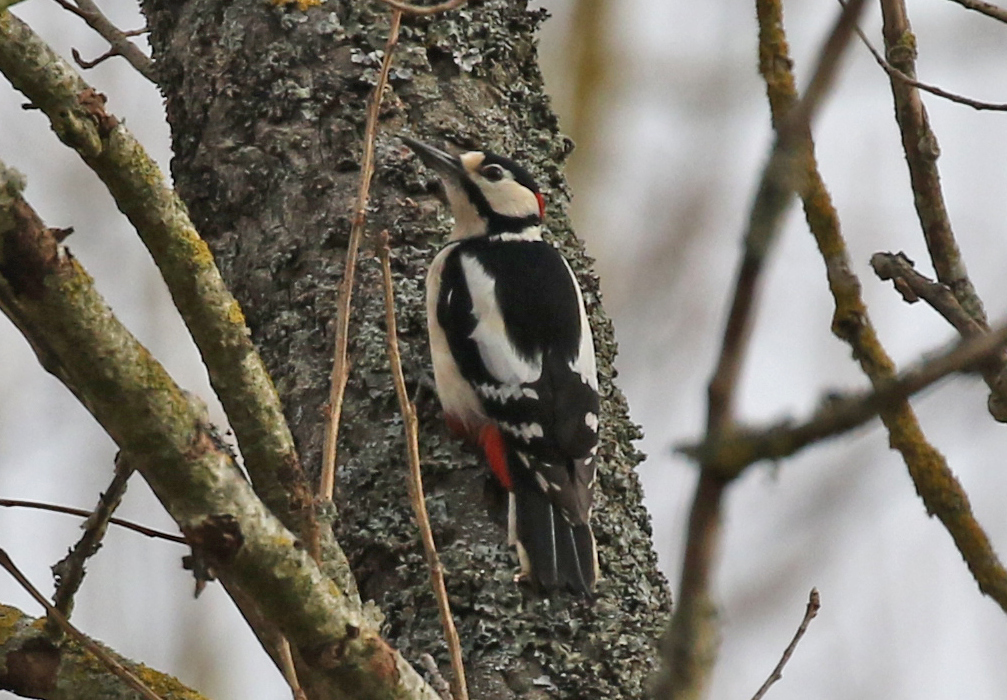
As we got around the corner, we could see a small group of people standing on the path looking up into the trees. We hurried up to them and they confirmed that they were watching the Lesser Spotted Woodpeckers, three of them together! They were displaying and we watched them chasing each other through the branches. Each time they landed, we got them in the scope, but they weren’t staying still for long.
The Lesser Spotted Woodpeckers disappeared back into the birches behind, then after a minute or so chased each other back out into the tops of the poplars. Two seemed to be in the lead, with the third woodpecker following behind. They gradually made their way further down through the trees and we managed to follow them for a while. Then they flew off further and we lost sight of them in some thicker trees further downstream.
We walked down to where we had seen the woodpeckers disappear, but there was no sign of them here. If they kept going as they had been they could be anywhere by now! There were a few more birds here. We found a Nuthatch excavating a hole in a tree and could see its head poke out from time to time to throw out the wood shavings. A Treecreeper made its way up the trunk of another tree. We noticed some movement on the vegetation trapped around a fallen tree across the river behind us and turned to see a Grey Wagtail feeding quietly.
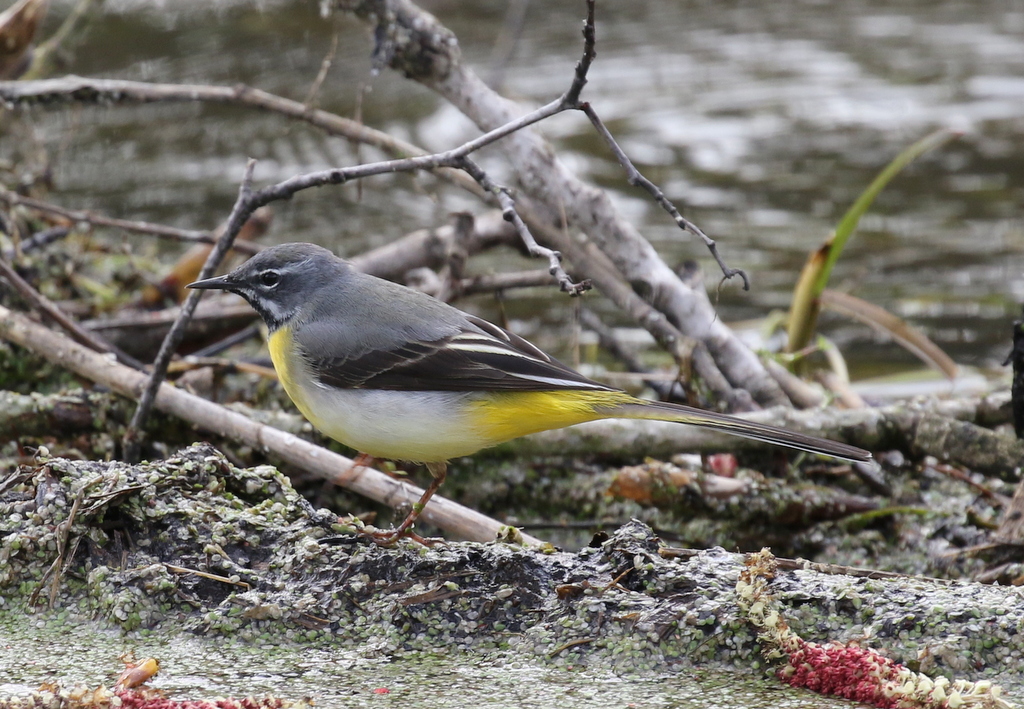
Someone coming back from further downstream told us the otters had been along the river much further down, so we thought we would go to try to see them. There were Chiffchaffs singing in the trees and we stopped to admire a Stock Dove whooping on top of a dead trunk. A Common Buzzard circled up over the trees beyond.
Another couple of photographers coming back along the path told us the otters were heading back our way so we stopped and waited but there was no sign of them. We had a quick look up and down the river, but presumably the otters had come out of the water and disappeared. We did find a Kingfisher which zipped off across the river as we approached.
As we made our way back, we looked and listened for the Lesser Spotted Woodpeckers but there was no further sign of them now. A Water Rail squealed from the far bank of the river and then flew across to our side, disappearing behind some trees. As we walked on, we found it on the other side of the path but it flew off into the reeds.
As we made our way back round by the reedbed, we stopped to admire the finches in the trees where they were coming down to drink from the pines. Finally we had better views of a smart male Brambling which perched up more obligingly. There were Bramblings singing here too – more of a wheeze than a song, but always interesting to hear. It won’t be long now before they are back off to Scandinavia for the breeding season.
It was sunny and warming up nicely now, so we made our way over to a place overlooking the forest. We hadn’t been out of the van long before we picked up two Goshawks circling up away to the east. They were both adults and both males. They soared higher and higher into the sky and we lost sight on one as the other drifted towards us. We could see their very white underparts and broad-based tails.
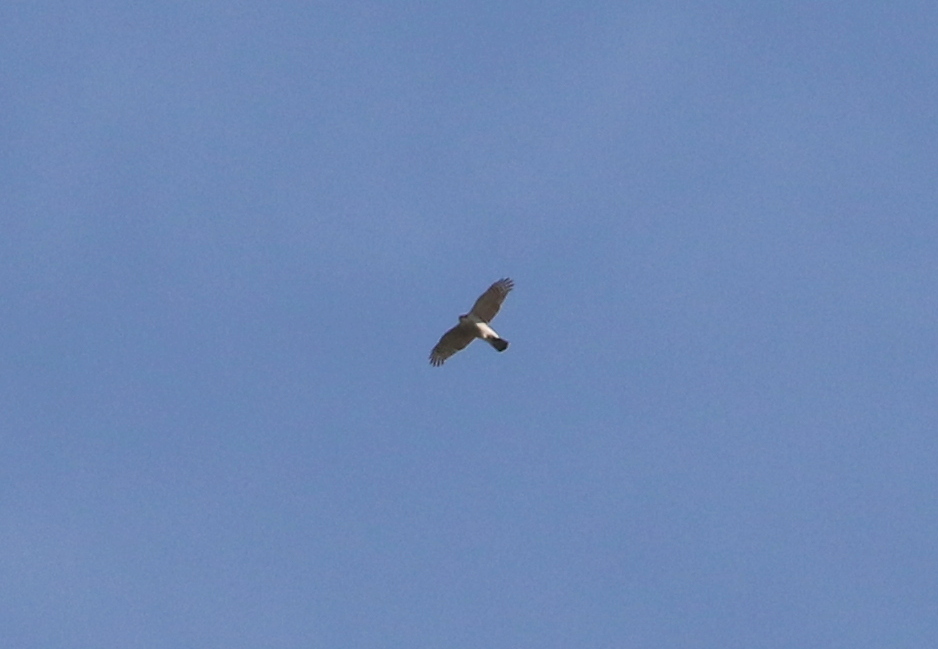
We had lost sight of them when a female Goshawk came up out of the trees close to where we had first seen the earlier ones. As it circled over the pines, we could see it was a big and powerful bird, with very pale grey upperparts. With the warm air, it gained height very quickly. Then we spotted a second Goshawk nearby, high in the blue sky. It was noticeably smaller, a male, possibly one of the two we had seen earlier. The female started to display, flying with deep, exaggerated wingbeats. Then presumably having warned off the male, she dropped back down towards the trees.
We were treated to great views of the Goshawks in the 45 minutes or so we spent here. There were lots of Common Buzzards up enjoying the thermals too, and a Kestrel. When a female Sparrowhawk came up out of the trees as well, we could see it looked smaller and darker grey. As it started flapping, we could see its very fast bursts of wingbeats.
There were a few Brown Hares in the fields here and one or two Lapwing and Red-legged Partridges. A Woodlark fluttered across at the back and disappeared over the trees beyond.
It was time for lunch now, so we headed over to Lynford Arboretum and made use of the picnic tables in the parking area. Afterwards, as we made our way over to the road, we heard a Firecrest singing from somewhere high in the fir trees. We stopped to listen for it, but unfortunately it had gone quiet.
Down at the gate, there was not much seed left on the ground and the feeders were looking rather empty too. There were still a few Bramblings and Chaffinches coming down to the leaves beyond the small pool and a Yellowhammer dropped down with them too.
Continuing on down towards the bridge, a large flock of Fieldfares flew over tchacking noisily. We looked up into the fir trees to see the Tawny Owl back hiding in its usual roost spot. It is very hard to see unless you are in just the right spot and the view is generally looking up from underneath it, so you often can’t see its head until it looks down.
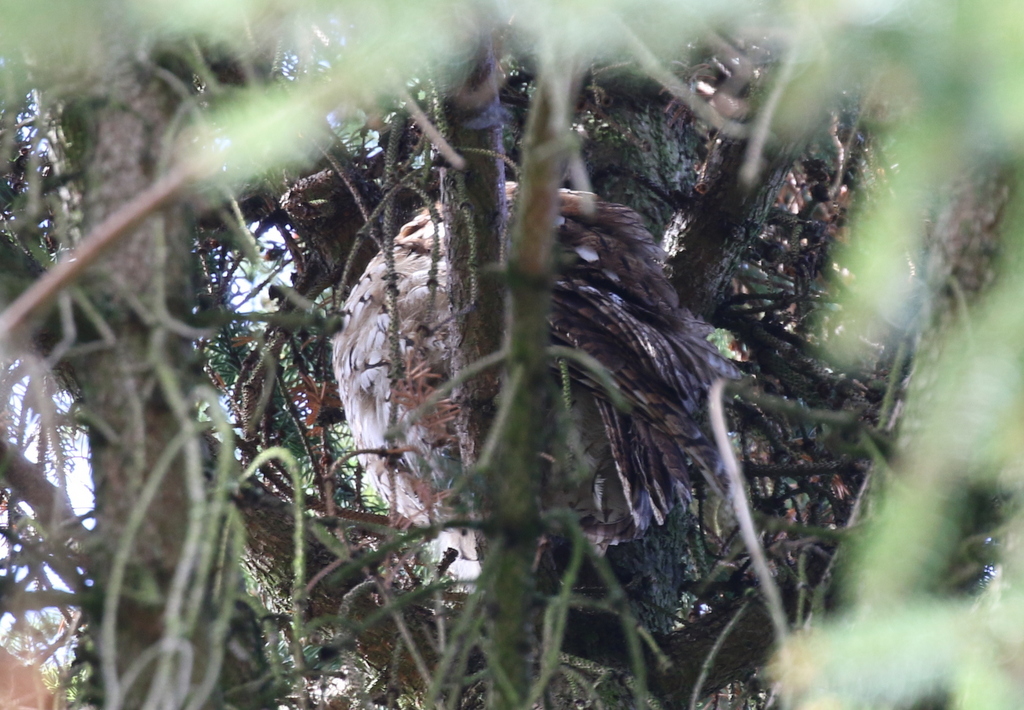
There were a few tits coming in to the seed put out on the pillars of the bridge, so we stopped to see what else we could see. A male Reed Bunting duly appeared. While we were scanning the trees, we noticed some movement deeper in and focusing on it with binoculars we could see a couple of Common Crossbills dropping down through the branches. We thought they might be about to come down to drink under the trees, so we hurried in along the path.
The Crossbills were still perched in the trees but seemed to be in no hurry to drink. At first they were just perched in different trees, but one by one they moved into an alder above the path where we watched them climbing about in the branches and picking at the flowers. By the end, they were right above our heads and we had a really good view of them through the scope. A Marsh Tit was flitting around in the bushes by the path too.
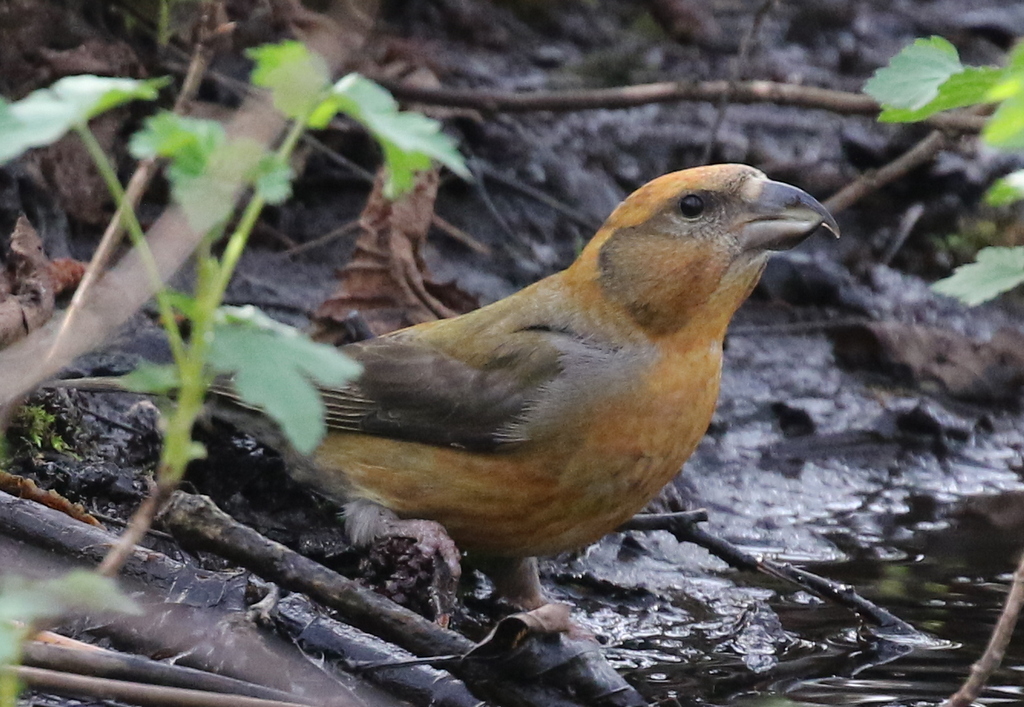
Then suddenly two of the Crossbills flew over our heads and down into some small trees just above the stream channel by the path. We positioned ourselves and had a great view of them as they came down to drink on the far bank – first a green female and then a rather orangey male. With a diet primarily of resinous pine seeds they need to drink regularly.
The Crossbills all flew back up into the trees towards the bridge, so we made our way back out. It was the turn of the Siskins now. A pair dropped out of the alders above the bridge and down to the reeds in the corner of the lake to drink. We had a great view of the bright yellow-green male when it flew back up into the trees.
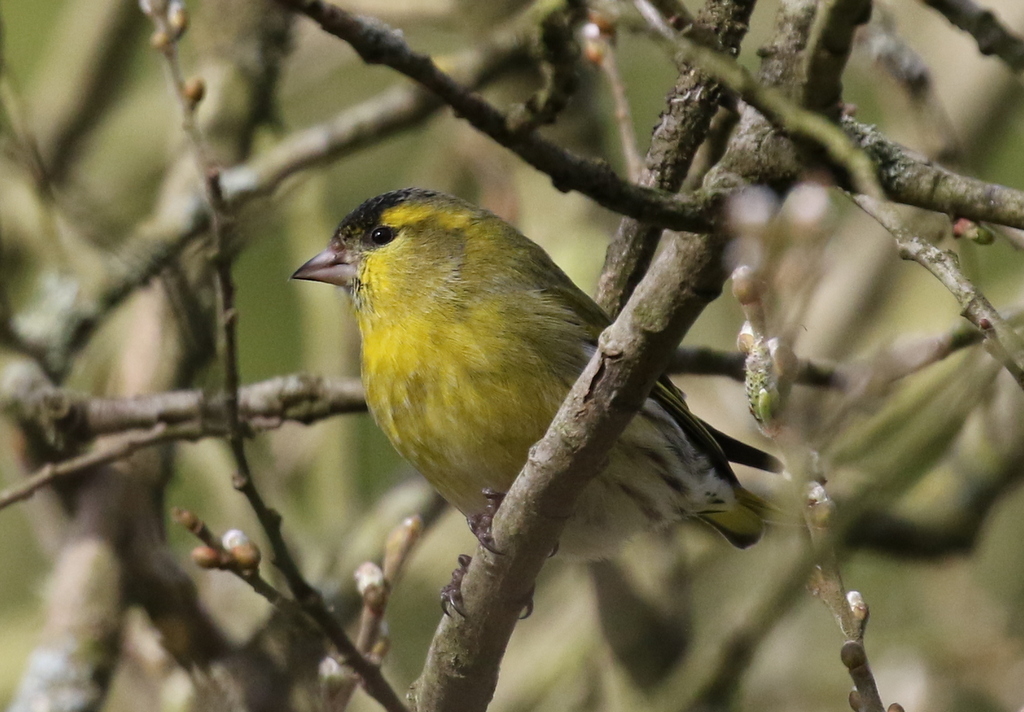
Having had great success at the bridge, we decided to walk up to the paddocks to see if we could find a Hawfinch. It was very quiet here in the trees though today – it seems likely that food is now getting in short supply here. It was still a bit too early for them to come in for a pre-roost gathering, so we decided to walk round via the lake.
A Little Grebe laughed at us maniacally from the reeds and another was diving under the overhanging trees on the edge of the island. We stopped to admire a pair of Gadwall on the lake, the drake looking particularly smart with its variety of different feather patterns. Not just a boring grey duck! There were a few Greylags and a pair of Canada Geese on the grass in front of the hall.
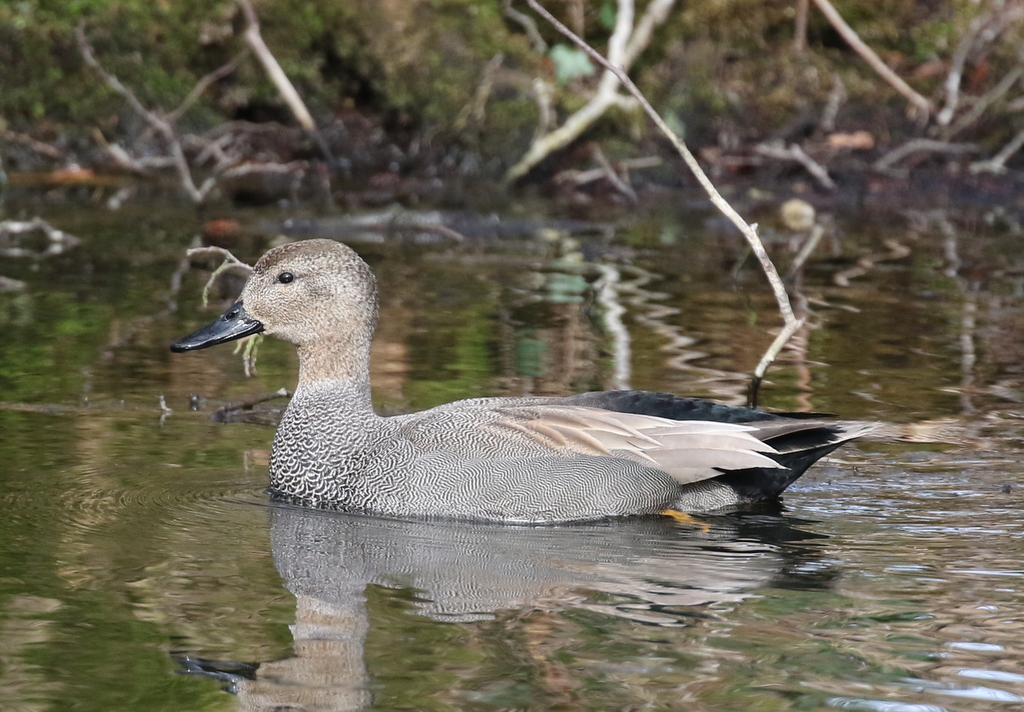
We walked round the far side of the paddocks, scanning the ground under the trees in the middle to see if we could see anything down in the grass. We found a pair of Goldcrests in the firs on the far side and a Redwing perched high in the poplars in the distance. We figured we could make our way back to the bridge and continue to scan the paddocks in case a Hawfinch should appear.
Back at the bridge, the Water Rail had now appeared. It was hiding in the reeds at first, but eventually came out a bit more into the open where we could get a good look at it.
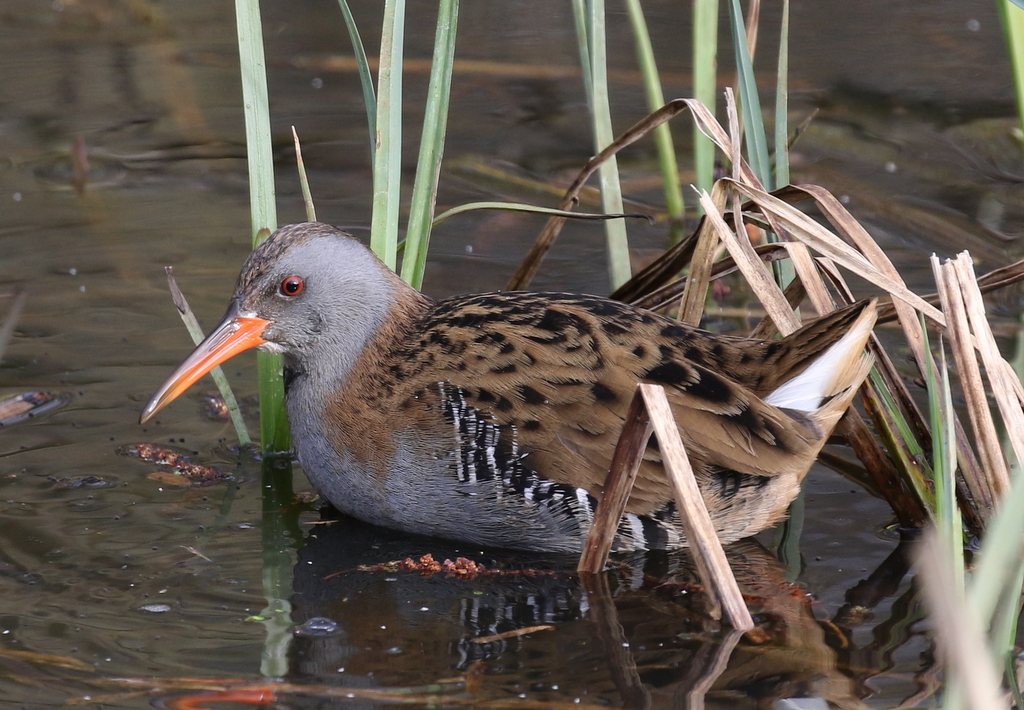
When we heard the ‘glip, glip’ calls of Crossbills, we looked up to see three brighter red males land in the trees above the pool. They made their way gradually down through the branches, before dropping down to the edge of the water to drink. Once again, we were well-placed for a ringside seat!
When they flew back up into the trees, one of the male Crossbills then spent a couple of minutes picking at the bare wood where a large bough had recently broken off one of the alders. Then it perched up in the sunshine on a branch just above.
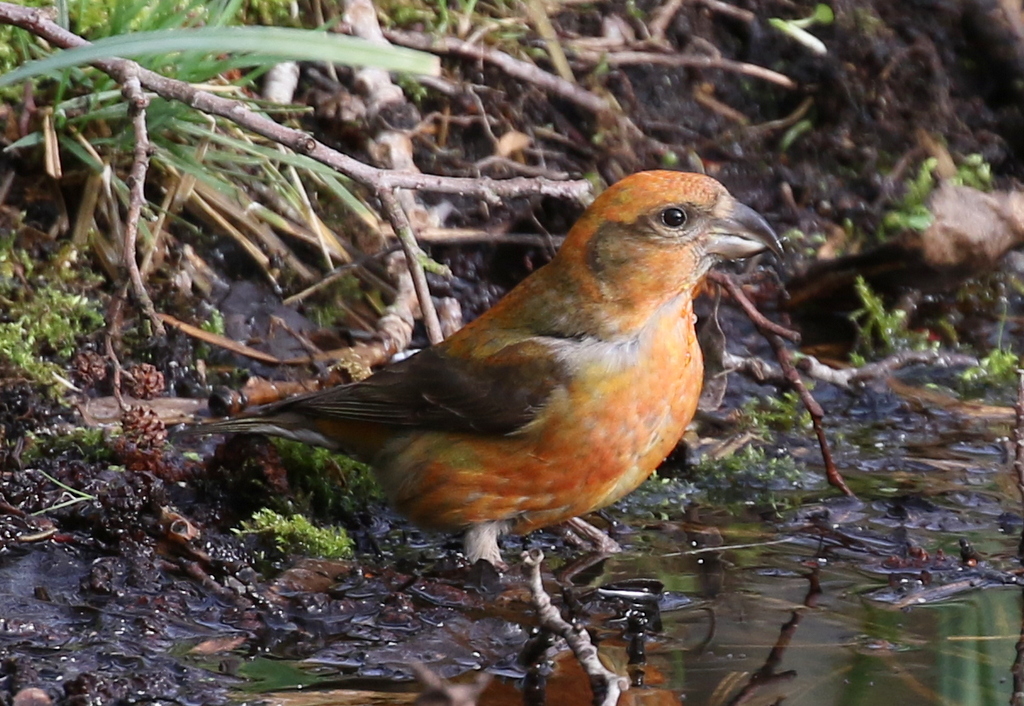
There was still no sign of the Hawfinches in the paddocks and we still had something else we hoped to do before the end of the day, so we decided to head off. A quick walk round back to the van and we drove over to Weeting Heath.
There had been no sign of the Rough-legged Buzzard for over an hour when we arrived, so we went into the visitor centre. While most of the group were queuing for the facilities, two of us walked back out to the car park. Just in time to see the back end of the Rough-legged Buzzard disappearing into the trees on the edge of the field opposite. There was no further sign of it by the time everyone had come back out again. A (Eurasian) Curlew was feeding in the winter wheat field over to one side.
We decided to go down to West Hide to look for the Stone Curlews. There have been three back already in the last week, and two were helpfully standing in the cultivated area towards the front. They were settled down, back onto us at first, but after a few minutes one of the Stone Curlews woke and stood up, turning round so we could get a good look at its pale iris and black-tipped yellow bill.
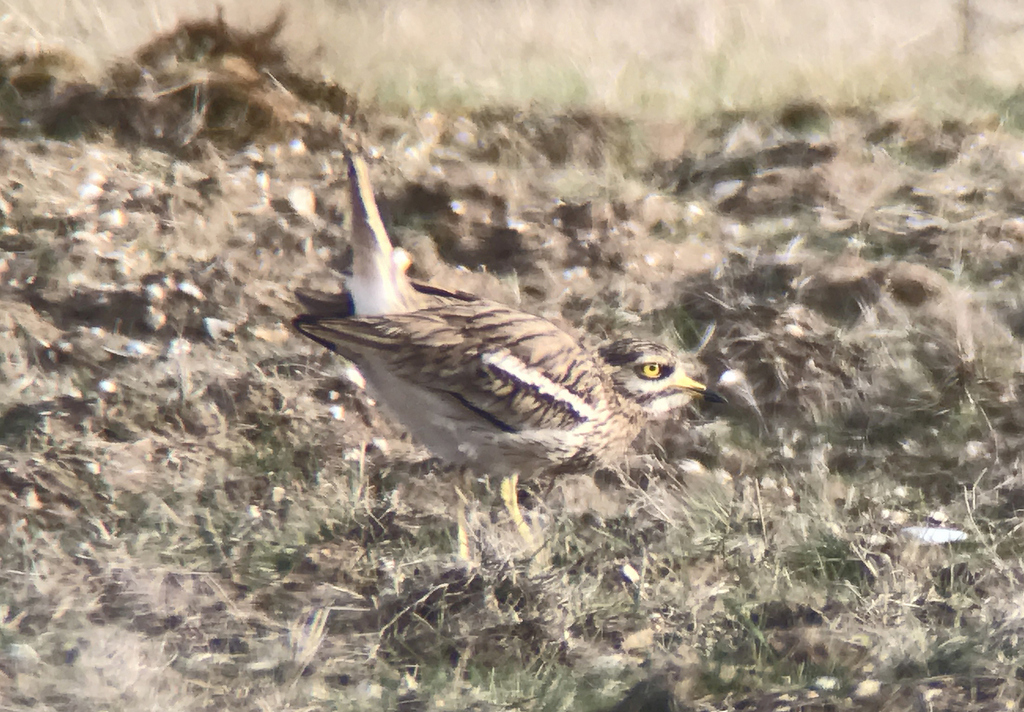
Being later in the afternoon now, and early in the year, there was next to no heat haze which can often be a problem at this site. So we could get a very good look at the Stone Curlews today. Having all had a really good look at them for a while, we decided to make our way back out.
There were a several people out on the verge now, but rather than looking out over the field opposite they were looking up the road. Apparently, the Rough-legged Buzzard had just been seen in a tree from the field entrance further along and someone had helpfully come over to tell everyone. We decided to walk up the road and sure enough, there was the Rough-legged Buzzard perched in a pine tree on the corner of the wood at the back of the field.
The Rough-legged Buzzard flew back round behind the trees, so we continued on to the field entrance, Shortly after we got there, the Rough-legged Buzzard flew out again and landed in another tree further beyond. We had a great view of its white tail with black terminal band as it flew back. Then it did another fly round and landed back in the pine tree closer to us, where we had seen it first. Now we could see its very pale head and contrasting blackish belly patch.
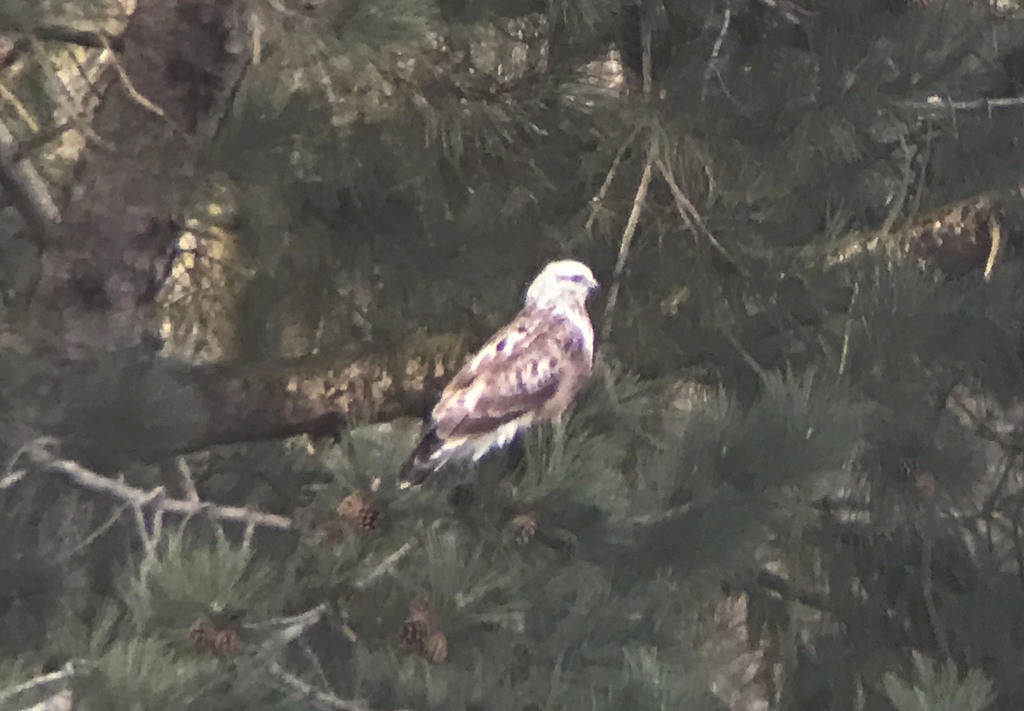
A flock of Linnets was whirling round the edge of the field beyond the gate and two Curlews flew up calling. Eventually the Rough-legged Buzzard dropped out of the pine and disappeared back round behind the trees again. It had been a great way to end our first day out, down in the Brecks, and it was time to head for home now.
















